 Vol.3, No.9, 795-801 (2011) Natural Science http://dx.doi.org/10.4236/ns.2011.39104 Copyright © 2011 SciRes. OPEN ACCESS The weighted quadratic index of biodiversity for pairs of species: a generalization of Rao’s index Radu Cornel Guiasu1*, Silviu Guiasu2 1Environmental and Health Studies Program, Department of Multidisciplinary Studies, Glendon College, York University, Toronto, Canada; *Corresponding Author: rguiasu@glendon.yorku.ca 2Department of Mathematics and Statistics, York University, Toronto, Canada; guiasus@pascal.math.yorku.ca Received 29 July 2011; revised 30 August 2011; accepted 20 September 2011. ABSTRACT The distribution of biodiversity at multiple sites of a region has been traditionally investigated through the additive partitioning of the regional biodiversity, called γ-diversity, into the average within-site biodiversity or α-diversity, and the biodiversity among sites, or β-diversity. The standard additive partitioning of diversity re- quires the use of a measure of diversity which is a concave function of the relative abundance of species, like the Shannon entropy or the Gini- Simpson index, for instance. When a phyloge- netic distance between species is also taken into account, Rao’s quadratic index has been used as a measure of dissimilarity. Rao’s index, however, is not a concave function of the dis- tribution of relative abundance of either indivi- dual species or pairs of species and, conse- quently, only some nonstandard additive parti- tionings of diversity have been given using this index. The objective of this paper is to show that the weighted quadratic index of biodiversity, a generalization of the weighted Gini-Simpson in- dex to the pairs of species, is a concave function of the joint distribution of the relative abun- dance of pairs of species and, therefore, may be used in the standard additive partitioning of di- versity instead of Rao’s index. The replication property of this new measure is also discussed. Keywords: Additive Partitioning of Biodiversity; Biodiversity Measures; Rao’s Index of Dissimilarity; Replication Property; Weighted Alpha-, Beta-, and Gamma-Diversities; Weighted Gini-Simpson Index 1. INTRODUCTION The amount of turnover among species assemblages is an important component for the conservation of biodi- versity. The diversity turnover is called β-diversity while the regional diversity and the mean of the local diversi- ties are called γ-diversity and α-diversity, respectively. Unlike the α-diversity and the γ-diversity, there is no consensus about how to interpret and calculate the β- diversity. According to Whittaker [1,2] who introduced the terminology, β-diversity is the ratio between γ-diver- sity and α-diversity. This is the multiplicative partition- ing of diversity. According to MacArthur [3], MacArthur and Wilson [4], and Lande [5], β-diversity is the diffe- rence between γ-diversity and α-diversity. This is the additive partitioning of diversity. Initially, the diversity measures used in the partitioning of diversity (such as the classic Shannon’s entropy [6] and the Gini-Simpson in- dex [7,8]) depended only on the relative abundance of species. Later, Rao [9] introduced a dissimilarity mea- sure that takes into account both the relative abundance of species and an arbitrary distance between species (for example, the phylogenetic distance). When Rao’s index is used as a measure in the additive partitioning of bio- diversity, β-diversity reflects the dissimilarity between the diversities of the sites of the respective region. Within the last decade or so, many published studies attempted to use Rao’s index in the additive partitioning of biodiversity. Some papers have looked for special types of distance matrices for which Rao’s index is a concave function of the distribution of the relative abun- dance of individual species. Other papers have looked for nonstandard, particular additive partitioning of diversity in α-, β-, and γ-diversities. The main difficulty comes from the fact that, for an arbitrary distance between spe- cies, Rao’s index is a quadratic, but not concave, func- tion of the distribution of the relative abundance of indi- vidual species and a linear, but not quadratic, function of the joint distribution of the relative abundance of distinct pairs of species and, as a consequence, it is not suited for the general standard additive partitioning into α-, β-, and γ-diversities. The present paper proposes the use of a 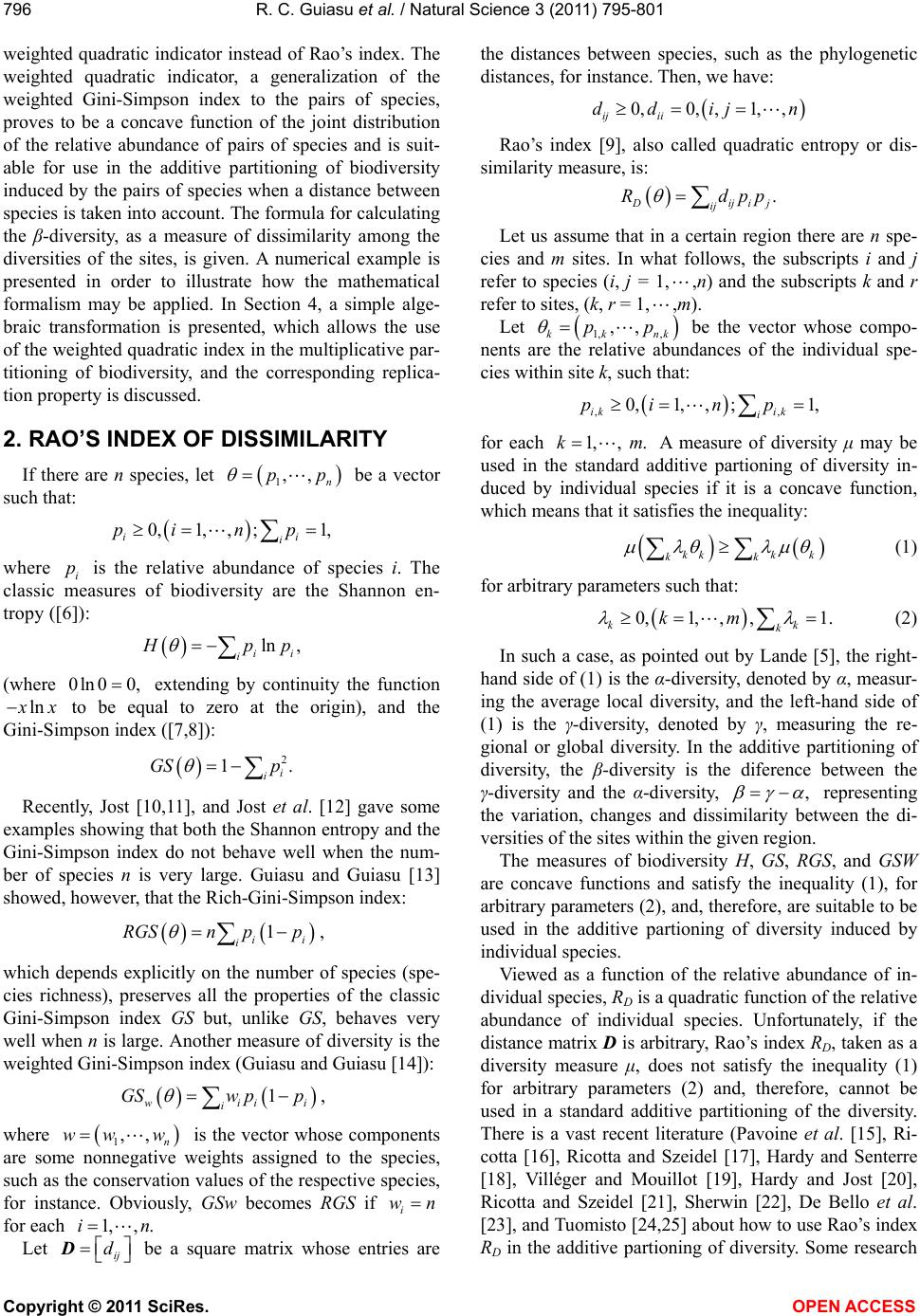 R. C. Guiasu et al. / Natural Science 3 (2011) 795-801 Copyright © 2011 SciRes. OPEN ACCESS 796 weighted quadratic indicator instead of Rao’s index. The weighted quadratic indicator, a generalization of the weighted Gini-Simpson index to the pairs of species, proves to be a concave function of the joint distribution of the relative abundance of pairs of species and is suit- able for use in the additive partitioning of biodiversity induced by the pairs of species when a distance between species is taken into account. The formula for calculating the β-diversity, as a measure of dissimilarity among the diversities of the sites, is given. A numerical example is presented in order to illustrate how the mathematical formalism may be applied. In Section 4, a simple alge- braic transformation is presented, which allows the use of the weighted quadratic index in the multiplicative par- titioning of biodiversity, and the corresponding replica- tion property is discussed. 2. RAO’S INDEX OF DISSIMILARITY If there are n species, let 1,, n pp be a vector such that: 0,1, ,;1, ii i pi np where i p is the relative abundance of species i. The classic measures of biodiversity are the Shannon en- tropy ([6]): ln , ii i pp (where 0ln0 0, extending by continuity the function ln x to be equal to zero at the origin), and the Gini-Simpson index ([7,8]): 2 1. i i GS p Recently, Jost [10,11], and Jost et al. [12] gave some examples showing that both the Shannon entropy and the Gini-Simpson index do not behave well when the num- ber of species n is very large. Guiasu and Guiasu [13] showed, however, that the Rich-Gini-Simpson index: 1 ii i RGSn pp , which depends explicitly on the number of species (spe- cies richness), preserves all the properties of the classic Gini-Simpson index GS but, unlike GS, behaves very well when n is large. Another measure of diversity is the weighted Gini-Simpson index (Guiasu and Guiasu [14]): 1 wiii i GSw pp , where 1,, n ww w is the vector whose components are some nonnegative weights assigned to the species, such as the conservation values of the respective species, for instance. Obviously, GSw becomes RGS if i wn for each 1,, .in Let ij d D be a square matrix whose entries are the distances between species, such as the phylogenetic distances, for instance. Then, we have: 0,0, ,1,, ij ii dd ijn Rao’s index [9], also called quadratic entropy or dis- similarity measure, is: . ij ij ij Rdpp Let us assume that in a certain region there are n spe- cies and m sites. In what follows, the subscripts i and j refer to species (i, j = 1,,n) and the subscripts k and r refer to sites, (k, r = 1,,m). Let 1, , ,, kknk pp be the vector whose compo- nents are the relative abundances of the individual spe- cies within site k, such that: ,, 0,1, ,;1, ik ik i pinp for each 1,, .km A measure of diversity μ may be used in the standard additive partioning of diversity in- duced by individual species if it is a concave function, which means that it satisfies the inequality: kkk k kk (1) for arbitrary parameters such that: 0,1, ,,1. kk k km (2) In such a case, as pointed out by Lande [5], the right- hand side of (1) is the α-diversity, denoted by α, measur- ing the average local diversity, and the left-hand side of (1) is the γ-diversity, denoted by γ, measuring the re- gional or global diversity. In the additive partitioning of diversity, the β-diversity is the diference between the γ-diversity and the α-diversity, , representing the variation, changes and dissimilarity between the di- versities of the sites within the given region. The measures of biodiversity H, GS, RGS, and GSW are concave functions and satisfy the inequality (1), for arbitrary parameters (2), and, therefore, are suitable to be used in the additive partioning of diversity induced by individual species. Viewed as a function of the relative abundance of in- dividual species, RD is a quadratic function of the relative abundance of individual species. Unfortunately, if the distance matrix D is arbitrary, Rao’s index RD, taken as a diversity measure μ, does not satisfy the inequality (1) for arbitrary parameters (2) and, therefore, cannot be used in a standard additive partitioning of the diversity. There is a vast recent literature (Pavoine et al. [15], Ri- cotta [16], Ricotta and Szeidel [17], Hardy and Senterre [18], Villéger and Mouillot [19], Hardy and Jost [20], Ricotta and Szeidel [21], Sherwin [22], De Bello et al. [23], and Tuomisto [24,25] about how to use Rao’s index RD in the additive partioning of diversity. Some research 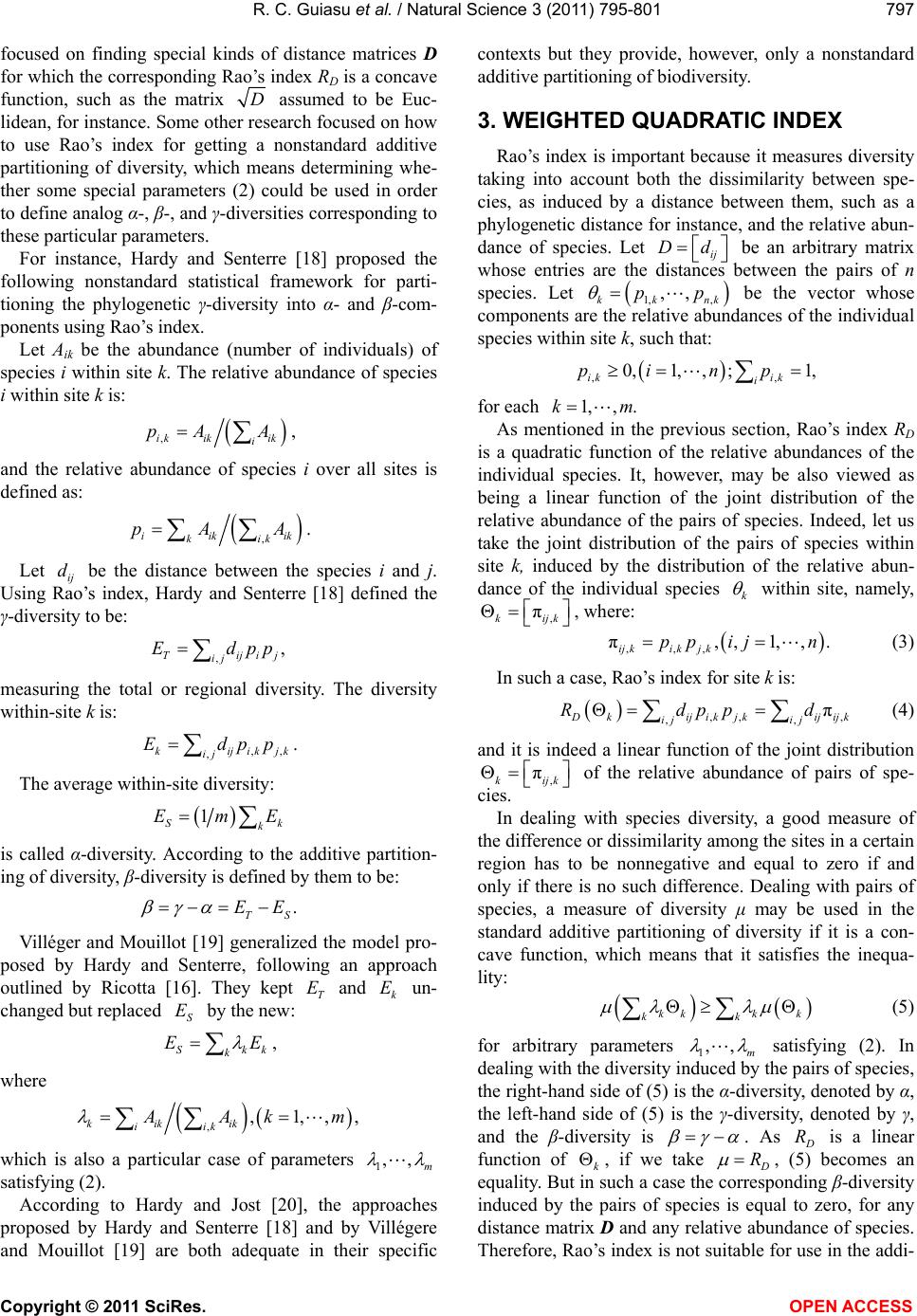 R. C. Guiasu et al. / Natural Science 3 (2011) 795-801 Copyright © 2011 SciRes. OPEN ACCESS 797 focused on finding special kinds of distance matrices D for which the corresponding Rao’s index RD is a concave function, such as the matrix D assumed to be Euc- lidean, for instance. Some other research focused on how to use Rao’s index for getting a nonstandard additive partitioning of diversity, which means determining whe- ther some special parameters (2) could be used in order to define analog α-, β-, and γ-diversities corresponding to these particular parameters. For instance, Hardy and Senterre [18] proposed the following nonstandard statistical framework for parti- tioning the phylogenetic γ-diversity into α- and β-com- ponents using Rao’s index. Let Aik be the abundance (number of individuals) of species i within site k. The relative abundance of species i within site k is: ,i kikik i pA A, and the relative abundance of species i over all sites is defined as: , iik ik kik pA A. Let ij d be the distance between the species i and j. Using Rao’s index, Hardy and Senterre [18] defined the γ-diversity to be: ,, Tijij ij Edpp measuring the total or regional diversity. The diversity within-site k is: ,, , kijikjk ij Edpp. The average within-site diversity: 1 Sk k EmE is called α-diversity. According to the additive partition- ing of diversity, β-diversity is defined by them to be: . TS EE Villéger and Mouillot [19] generalized the model pro- posed by Hardy and Senterre, following an approach outlined by Ricotta [16]. They kept T E and k E un- changed but replaced S E by the new: Skk k EE , where ,,1,,, kik ik iik Ak m which is also a particular case of parameters 1,, m satisfying (2). According to Hardy and Jost [20], the approaches proposed by Hardy and Senterre [18] and by Villégere and Mouillot [19] are both adequate in their specific contexts but they provide, however, only a nonstandard additive partitioning of biodiversity. 3. WEIGHTED QUADRATIC INDEX Rao’s index is important because it measures diversity taking into account both the dissimilarity between spe- cies, as induced by a distance between them, such as a phylogenetic distance for instance, and the relative abun- dance of species. Let ij Dd be an arbitrary matrix whose entries are the distances between the pairs of n species. Let 1, , ,, kknk pp be the vector whose components are the relative abundances of the individual species within site k, such that: ,, 0,1, ,;1, ik ik i pinp for each 1,, .km As mentioned in the previous section, Rao’s index RD is a quadratic function of the relative abundances of the individual species. It, however, may be also viewed as being a linear function of the joint distribution of the relative abundance of the pairs of species. Indeed, let us take the joint distribution of the pairs of species within site k, induced by the distribution of the relative abun- dance of the individual species k within site, namely, , π kijk , where: ,,, π,,1, , . ij ki kj k pp ijn (3) In such a case, Rao’s index for site k is: ,, , ,, π kijikjkijijk ij ij Rdppd (4) and it is indeed a linear function of the joint distribution , π kijk of the relative abundance of pairs of spe- cies. In dealing with species diversity, a good measure of the difference or dissimilarity among the sites in a certain region has to be nonnegative and equal to zero if and only if there is no such difference. Dealing with pairs of species, a measure of diversity μ may be used in the standard additive partitioning of diversity if it is a con- cave function, which means that it satisfies the inequa- lity: kkk k kk (5) for arbitrary parameters 1,, m satisfying (2). In dealing with the diversity induced by the pairs of species, the right-hand side of (5) is the α-diversity, denoted by α, the left-hand side of (5) is the γ-diversity, denoted by γ, and the β-diversity is . As R is a linear function of k , if we take R , (5) becomes an equality. But in such a case the corresponding β-diversity induced by the pairs of species is equal to zero, for any distance matrix D and any relative abundance of species. Therefore, Rao’s index is not suitable for use in the addi- 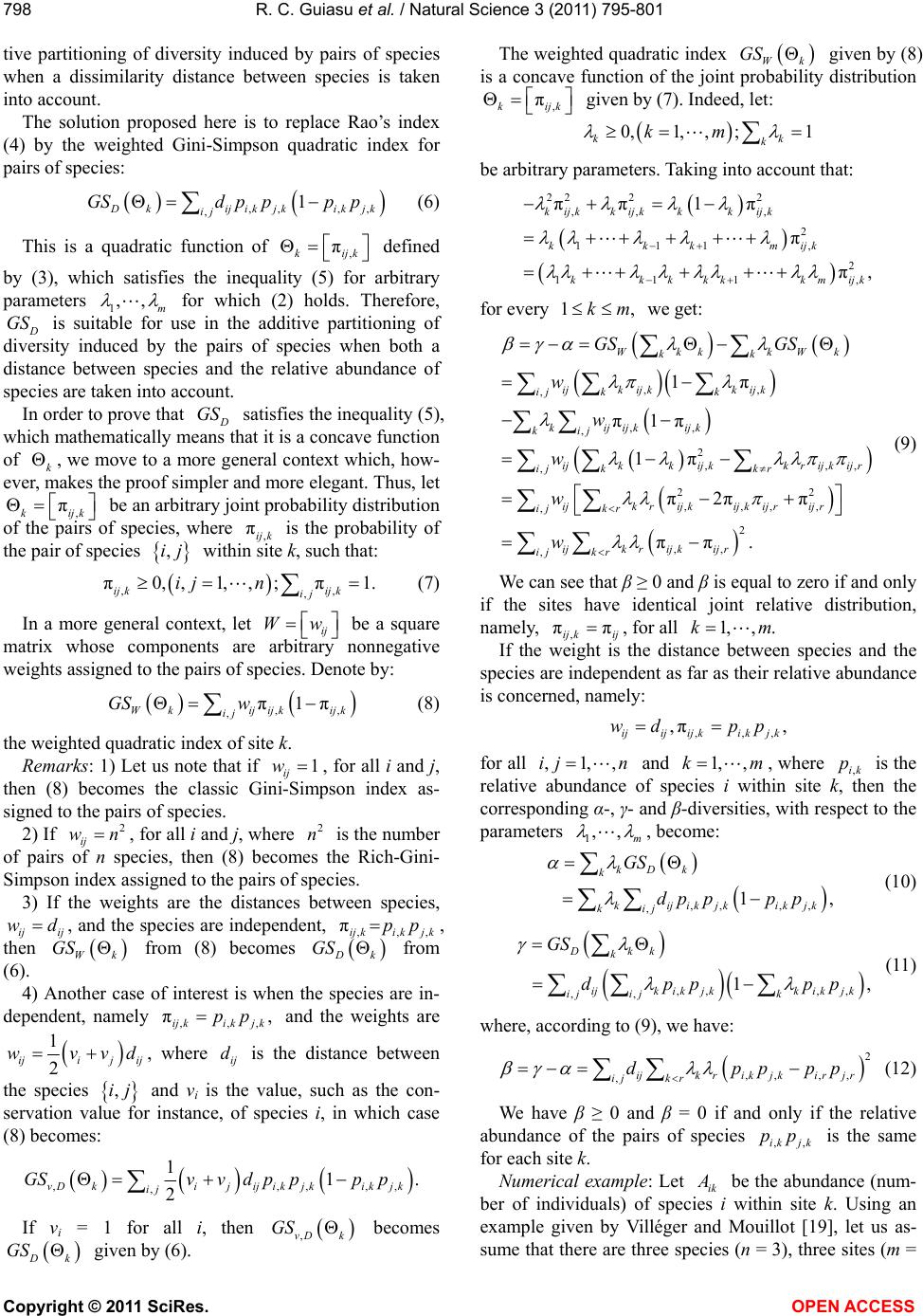 R. C. Guiasu et al. / Natural Science 3 (2011) 795-801 Copyright © 2011 SciRes. OPEN ACCESS 798 tive partitioning of diversity induced by pairs of species when a dissimilarity distance between species is taken into account. The solution proposed here is to replace Rao’s index (4) by the weighted Gini-Simpson quadratic index for pairs of species: ,, ,, ,1 kijikjkikjk ij GSd pppp (6) This is a quadratic function of , π kijk defined by (3), which satisfies the inequality (5) for arbitrary parameters 1,, m for which (2) holds. Therefore, GS is suitable for use in the additive partitioning of diversity induced by the pairs of species when both a distance between species and the relative abundance of species are taken into account. In order to prove that GS satisfies the inequality (5), which mathematically means that it is a concave function of k , we move to a more general context which, how- ever, makes the proof simpler and more elegant. Thus, let , π kijk be an arbitrary joint probability distribution of the pairs of species, where , πij k is the probability of the pair of species ,ij within site k, such that: ,, , π0, ,1,,;π1. ij kij k ij ij n (7) In a more general context, let ij Ww be a square matrix whose components are arbitrary nonnegative weights assigned to the pairs of species. Denote by: ,, ,π1π Wkijijkij k ij GS w (8) the weighted quadratic index of site k. Remarks: 1) Let us note that if 1 ij w, for all i and j, then (8) becomes the classic Gini-Simpson index as- signed to the pairs of species. 2) If 2 ij wn, for all i and j, where 2 n is the number of pairs of n species, then (8) becomes the Rich-Gini- Simpson index assigned to the pairs of species. 3) If the weights are the distances between species, ij ij wd, and the species are independent, ,,, πij ki kj k pp , then Wk GS from (8) becomes k GS from (6). 4) Another case of interest is when the species are in- dependent, namely ,,, π, ij kikjk pp and the weights are 1 2 ijijij wvvd , where ij d is the distance between the species ,ij and vi is the value, such as the con- servation value for instance, of species i, in which case (8) becomes: ,,,,, , 11. 2 vDkij ijikjkikjk ij GSvvdp pp p If vi = 1 for all i, then ,vDk GS becomes k GS given by (6). The weighted quadratic index Wk GS given by (8) is a concave function of the joint probability distribution , π kijk given by (7). Indeed, let: 0,1, ,;1 kk k km be arbitrary parameters. Taking into account that: 22 22 ,, , 2 111 , 2 111 , ππ 1π π π, kijkk ijkkkijk kkkmijk kkkkkkmijk for every 1,km we get: ,, , ,, , 2 ,,, , 22 ,,,, , 2 ,, , 1π π1π 1π π2ππ ππ. Wkk kWk kk ijkij kkij k ij kk kijijkijk kij ijkkijkkrij kij r ijkk r ijkrijkijkij rijr ijk r ijkrij kij r ijk r GS GS w w w w w (9) We can see that β ≥ 0 and β is equal to zero if and only if the sites have identical joint relative distribution, namely, , ππ ij kij , for all 1,, .km If the weight is the distance between species and the species are independent as far as their relative abundance is concerned, namely: ,,, ,π, ijijij kikj k wd pp for all ,1,,ijn and 1, ,km, where ,ik p is the relative abundance of species i within site k, then the corresponding α-, γ- and β-diversities, with respect to the parameters 1,, m , become: ,, ,, , 1, kDk k k ijikjk ikjk kij GS dp pp p (10) ,, ,, ,, 1, Dkk k ijki kj kki kj k ij ijk GS dpp pp (11) where, according to (9), we have: 2 ,, ,, ,ijk rikjkirjr ijk r dpppp (12) We have β ≥ 0 and β = 0 if and only if the relative abundance of the pairs of species ,,ikjk pp is the same for each site k. Numerical example: Let ik be the abundance (num- ber of individuals) of species i within site k. Using an example given by Villéger and Mouillot [19], let us as- sume that there are three species (n = 3), three sites (m = 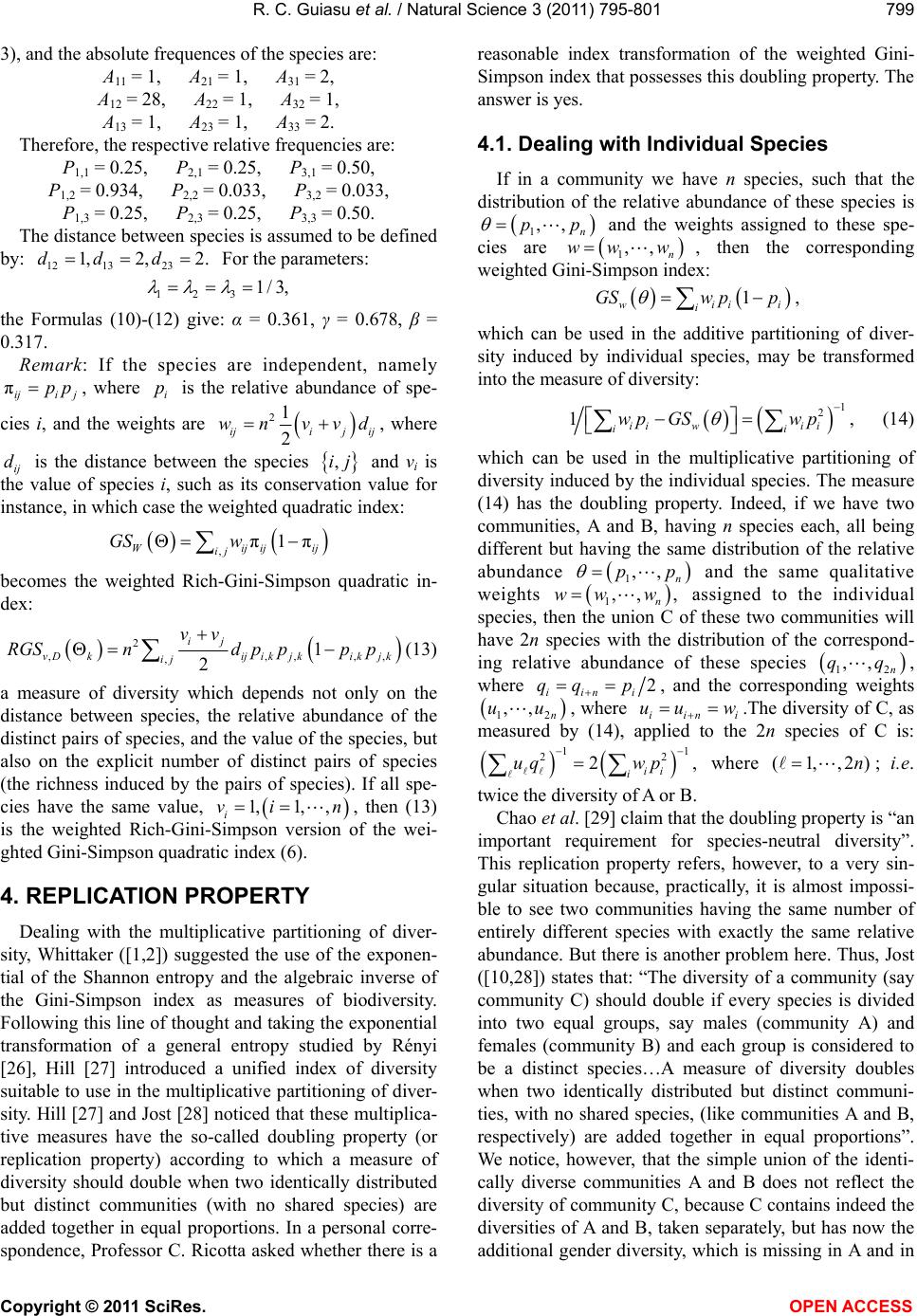 R. C. Guiasu et al. / Natural Science 3 (2011) 795-801 Copyright © 2011 SciRes. OPEN ACCESS 799 3), and the absolute frequences of the species are: A11 = 1, A21 = 1, A31 = 2, A12 = 28, A22 = 1, A32 = 1, A13 = 1, A23 = 1, A33 = 2. Therefore, the respective relative frequencies are: P1,1 = 0.25, P2,1 = 0.25, P3,1 = 0.50, P1,2 = 0.934, P2,2 = 0.033, P3,2 = 0.033, P1,3 = 0.25, P2,3 = 0.25, P3,3 = 0.50. The distance between species is assumed to be defined by: 121323 1, 2,2.dd d For the parameters: 123 1/3, the Formulas (10)-(12) give: α = 0.361, γ = 0.678, β = 0.317. Remark: If the species are independent, namely πiji j pp, where i p is the relative abundance of spe- cies i, and the weights are 21 2 ijijij wn vvd, where ij d is the distance between the species ,ij and vi is the value of species i, such as its conservation value for instance, in which case the weighted quadratic index: ,π1π Wijijij ij GS w becomes the weighted Rich-Gini-Simpson quadratic in- dex: 2 ,,,,, ,1 2 ij vD kijikjkikjk ij vv RGSndp ppp (13) a measure of diversity which depends not only on the distance between species, the relative abundance of the distinct pairs of species, and the value of the species, but also on the explicit number of distinct pairs of species (the richness induced by the pairs of species). If all spe- cies have the same value, 1,1, , i vi n, then (13) is the weighted Rich-Gini-Simpson version of the wei- ghted Gini-Simpson quadratic index (6). 4. REPLICATION PROPERTY Dealing with the multiplicative partitioning of diver- sity, Whittaker ([1,2]) suggested the use of the exponen- tial of the Shannon entropy and the algebraic inverse of the Gini-Simpson index as measures of biodiversity. Following this line of thought and taking the exponential transformation of a general entropy studied by Rényi [26], Hill [27] introduced a unified index of diversity suitable to use in the multiplicative partitioning of diver- sity. Hill [27] and Jost [28] noticed that these multiplica- tive measures have the so-called doubling property (or replication property) according to which a measure of diversity should double when two identically distributed but distinct communities (with no shared species) are added together in equal proportions. In a personal corre- spondence, Professor C. Ricotta asked whether there is a reasonable index transformation of the weighted Gini- Simpson index that possesses this doubling property. The answer is yes. 4.1. Dealing with Individual Species If in a community we have n species, such that the distribution of the relative abundance of these species is 1,, n pp and the weights assigned to these spe- cies are 1,, n ww w, then the corresponding weighted Gini-Simpson index: 1 wiii i GSw pp , which can be used in the additive partitioning of diver- sity induced by individual species, may be transformed into the measure of diversity: 1 2 1iiwii ii wp GSwp , (14) which can be used in the multiplicative partitioning of diversity induced by the individual species. The measure (14) has the doubling property. Indeed, if we have two communities, A and B, having n species each, all being different but having the same distribution of the relative abundance 1,, n pp and the same qualitative weights 1,, , n ww w assigned to the individual species, then the union C of these two communities will have 2n species with the distribution of the correspond- ing relative abundance of these species 12 ,,n qq, where 2 iin i qq p , and the corresponding weights 12 ,, n uu, where iini uuw .The diversity of C, as measured by (14), applied to the 2n species of C is: 11 22 2, ii i uqwp where (1,,2)n ; i.e. twice the diversity of A or B. Chao et al. [29] claim that the doubling property is “an important requirement for species-neutral diversity”. This replication property refers, however, to a very sin- gular situation because, practically, it is almost impossi- ble to see two communities having the same number of entirely different species with exactly the same relative abundance. But there is another problem here. Thus, Jost ([10,28]) states that: “The diversity of a community (say community C) should double if every species is divided into two equal groups, say males (community A) and females (community B) and each group is considered to be a distinct species…A measure of diversity doubles when two identically distributed but distinct communi- ties, with no shared species, (like communities A and B, respectively) are added together in equal proportions”. We notice, however, that the simple union of the identi- cally diverse communities A and B does not reflect the diversity of community C, because C contains indeed the diversities of A and B, taken separately, but has now the additional gender diversity, which is missing in A and in 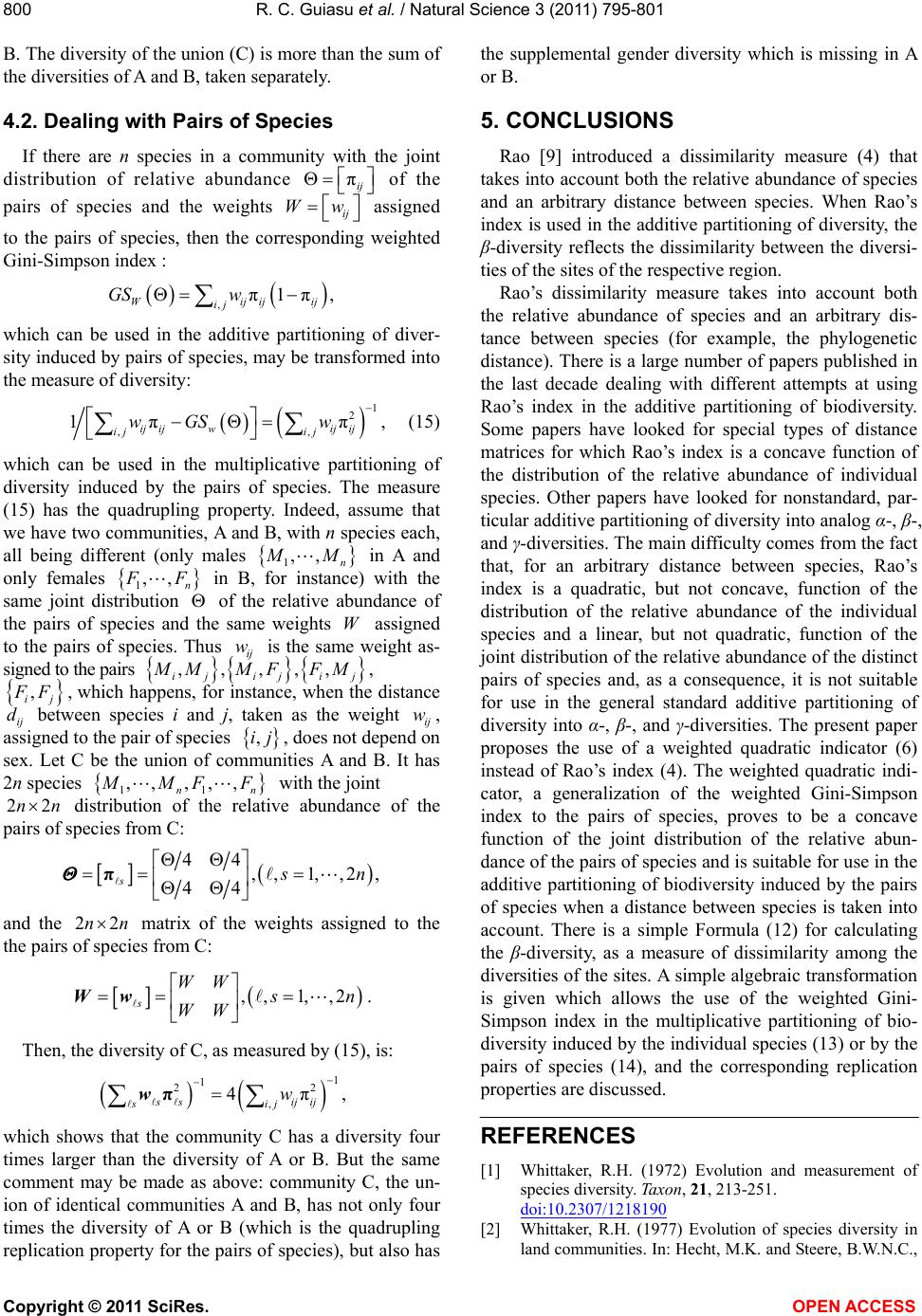 R. C. Guiasu et al. / Natural Science 3 (2011) 795-801 Copyright © 2011 SciRes. OPEN ACCESS 800 B. The diversity of the union (C) is more than the sum of the diversities of A and B, taken separately. 4.2. Dealing with Pairs of Species If there are n species in a community with the joint distribution of relative abundance πij of the pairs of species and the weights ij Ww assigned to the pairs of species, then the corresponding weighted Gini-Simpson index : ,π1π, Wijijij ij GS w which can be used in the additive partitioning of diver- sity induced by pairs of species, may be transformed into the measure of diversity: 1 2 ,, 1ππ, ij ijwij ij ij ij wGS w (15) which can be used in the multiplicative partitioning of diversity induced by the pairs of species. The measure (15) has the quadrupling property. Indeed, assume that we have two communities, A and B, with n species each, all being different (only males 1,,n M in A and only females 1,, n F in B, for instance) with the same joint distribution of the relative abundance of the pairs of species and the same weights W assigned to the pairs of species. Thus ij w is the same weight as- signed to the pairs ,,,,, ijijij MMFFM, , ij F, which happens, for instance, when the distance ij d between species i and j, taken as the weight ij w, assigned to the pair of species ,ij, does not depend on sex. Let C be the union of communities A and B. It has 2n species 11 ,, ,,, nn MF F with the joint 22nn distribution of the relative abundance of the pairs of species from C: 44 ,,1,,2, 44 s n π and the 22nn matrix of the weights assigned to the the pairs of species from C: ,,1,,2 s WW n WW Ww . Then, the diversity of C, as measured by (15), is: 1 1 22 , 4π ssij ij sij w π w, which shows that the community C has a diversity four times larger than the diversity of A or B. But the same comment may be made as above: community C, the un- ion of identical communities A and B, has not only four times the diversity of A or B (which is the quadrupling replication property for the pairs of species), but also has the supplemental gender diversity which is missing in A or B. 5. CONCLUSIONS Rao [9] introduced a dissimilarity measure (4) that takes into account both the relative abundance of species and an arbitrary distance between species. When Rao’s index is used in the additive partitioning of diversity, the β-diversity reflects the dissimilarity between the diversi- ties of the sites of the respective region. Rao’s dissimilarity measure takes into account both the relative abundance of species and an arbitrary dis- tance between species (for example, the phylogenetic distance). There is a large number of papers published in the last decade dealing with different attempts at using Rao’s index in the additive partitioning of biodiversity. Some papers have looked for special types of distance matrices for which Rao’s index is a concave function of the distribution of the relative abundance of individual species. Other papers have looked for nonstandard, par- ticular additive partitioning of diversity into analog α-, β-, and γ-diversities. The main difficulty comes from the fact that, for an arbitrary distance between species, Rao’s index is a quadratic, but not concave, function of the distribution of the relative abundance of the individual species and a linear, but not quadratic, function of the joint distribution of the relative abundance of the distinct pairs of species and, as a consequence, it is not suitable for use in the general standard additive partitioning of diversity into α-, β-, and γ-diversities. The present paper proposes the use of a weighted quadratic indicator (6) instead of Rao’s index (4). The weighted quadratic indi- cator, a generalization of the weighted Gini-Simpson index to the pairs of species, proves to be a concave function of the joint distribution of the relative abun- dance of the pairs of species and is suitable for use in the additive partitioning of biodiversity induced by the pairs of species when a distance between species is taken into account. There is a simple Formula (12) for calculating the β-diversity, as a measure of dissimilarity among the diversities of the sites. A simple algebraic transformation is given which allows the use of the weighted Gini- Simpson index in the multiplicative partitioning of bio- diversity induced by the individual species (13) or by the pairs of species (14), and the corresponding replication properties are discussed. REFERENCES [1] Whittaker, R.H. (1972) Evolution and measurement of species diversity. Taxon, 21, 213-251. doi:10.2307/1218190 [2] Whittaker, R.H. (1977) Evolution of species diversity in land communities. In: Hecht, M.K. and Steere, B.W.N.C., 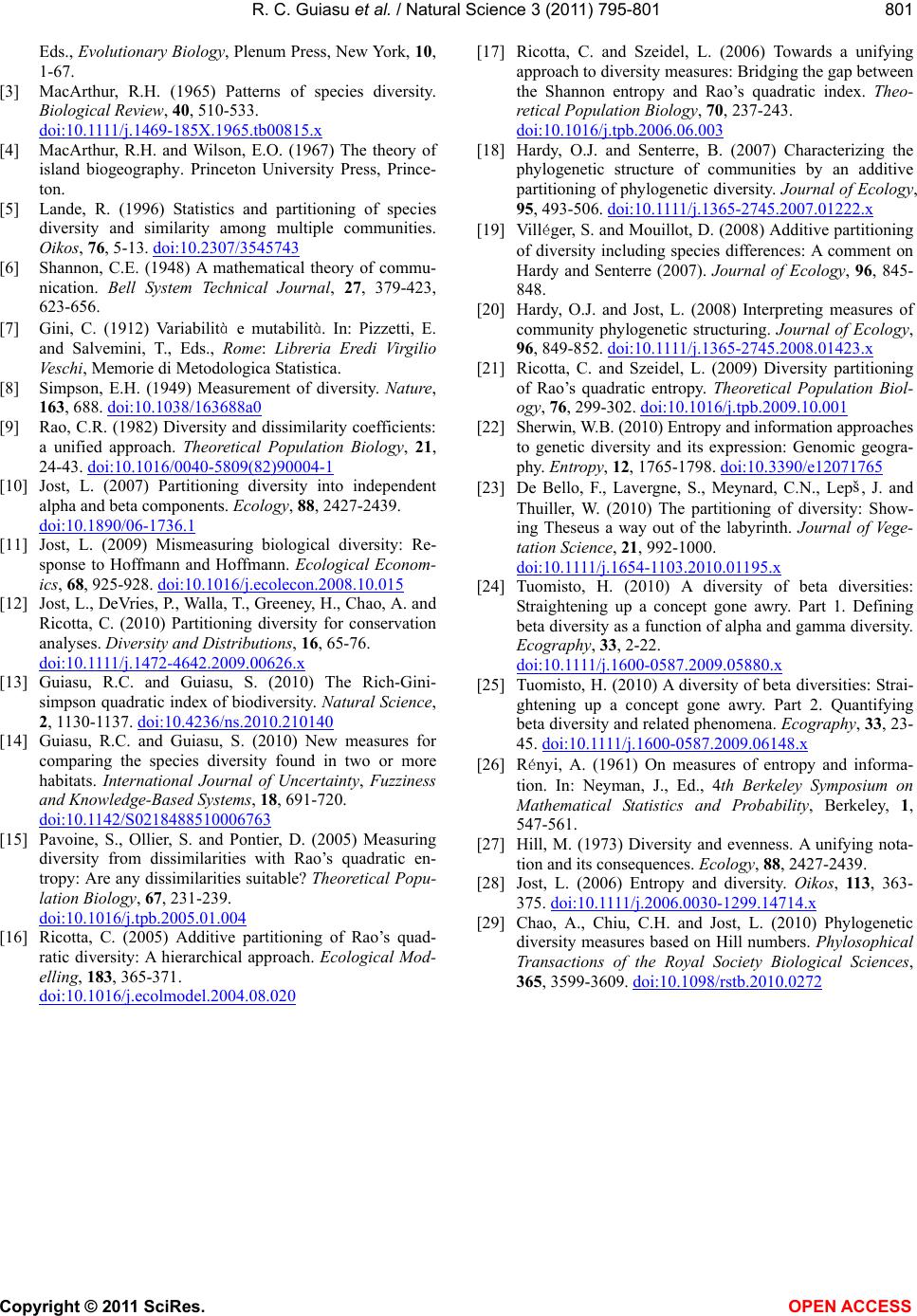 R. C. Guiasu et al. / Natural Science 3 (2011) 795-801 Copyright © 2011 SciRes. OPEN ACCESS 801 Eds., Evolutionary Biology, Plenum Press, New York, 10, 1-67. [3] MacArthur, R.H. (1965) Patterns of species diversity. Biological Review, 40, 510-533. doi: 10.1111 /j.1 469-185X.1965.tb00815.x [4] MacArthur, R.H. and Wilson, E.O. (1967) The theory of island biogeography. Princeton University Press, Prince- ton. [5] Lande, R. (1996) Statistics and partitioning of species diversity and similarity among multiple communities. Oikos, 76, 5-13. doi:10.2307/3545743 [6] Shannon, C.E. (1948) A mathematical theory of commu- nication. Bell System Technical Journal, 27, 379-423, 623-656. [7] Gini, C. (1912) Variabilità e mutabilità. In: Pizzetti, E. and Salvemini, T., Eds., Rome: Libreria Eredi Virgilio Veschi, Memorie di Metodologica Statistica. [8] Simpson, E.H. (1949) Measurement of diversity. Nature, 163, 688. doi:10.1038/163688a0 [9] Rao, C.R. (1982) Diversity and dissimilarity coefficients: a unified approach. Theoretical Population Biology, 21, 24-43. doi:10.1016/0040-5809(82)90004-1 [10] Jost, L. (2007) Partitioning diversity into independent alpha and beta components. Ecology, 88, 2427-2439. doi:10.1890/06-1736.1 [11] Jost, L. (2009) Mismeasuring biological diversity: Re- sponse to Hoffmann and Hoffmann. Ecological Econom- ics, 68, 925-928. doi:10.1016/j.ecolecon.2008.10.015 [12] Jost, L., DeVries, P., Walla, T., Greeney, H., Chao, A. and Ricotta, C. (2010) Partitioning diversity for conservation analyses. Diversity and Distributions, 16, 65-76. doi: 10.1111 /j.1 472-4642.2009.00626.x [13] Guiasu, R.C. and Guiasu, S. (2010) The Rich-Gini- simpson quadratic index of biodiversity. Natural Science, 2, 1130-1137. doi:10.4236/ns.2010.210140 [14] Guiasu, R.C. and Guiasu, S. (2010) New measures for comparing the species diversity found in two or more habitats. International Journal of Uncertainty, Fuzziness and Knowledge-Based Systems, 18, 691-720. doi:10.1142/S0218488510006763 [15] Pavoine, S., Ollier, S. and Pontier, D. (2005) Measuring diversity from dissimilarities with Rao’s quadratic en- tropy: Are any dissimilarities suitable? Theoretical Popu- lation Biology, 67 , 231-239. doi:10.1016/j.tpb.2005.01.004 [16] Ricotta, C. (2005) Additive partitioning of Rao’s quad- ratic diversity: A hierarchical approach. Ecological Mod- elling, 183, 365-371. doi:10.1016/j.ecolmodel.2004.08.020 [17] Ricotta, C. and Szeidel, L. (2006) Towards a unifying approach to diversity measures: Bridging the gap between the Shannon entropy and Rao’s quadratic index. Theo- retical Population Biology, 70, 237-243. doi:10.1016/j.tpb.2006.06.003 [18] Hardy, O.J. and Senterre, B. (2007) Characterizing the phylogenetic structure of communities by an additive partitioning of phylogenetic diversity. Journal of Ecology, 95, 493-506. doi :10. 1111/j. 1365-2745.2007.01222.x [19] Villéger, S. and Mouillot, D. (2008) Additive partitioning of diversity including species differences: A comment on Hardy and Senterre (2007). Journal of Ecology, 96, 845- 848. [20] Hardy, O.J. and Jost, L. (2008) Interpreting measures of community phylogenetic structuring. Journal of Ecology, 96, 849-852. doi :10. 1111/j. 1365-2745.2008.01423.x [21] Ricotta, C. and Szeidel, L. (2009) Diversity partitioning of Rao’s quadratic entropy. Theoretical Population Biol- ogy, 76, 299-302. doi:10.1016/j.tpb.2009.10.001 [22] Sherwin, W.B. (2010) Entropy and information approaches to genetic diversity and its expression: Genomic geogra- phy. Entropy, 12, 1765-1798. doi:10.3390/e12071765 [23] De Bello, F., Lavergne, S., Meynard, C.N., Lepš, J. and Thuiller, W. (2010) The partitioning of diversity: Show- ing Theseus a way out of the labyrinth. Journal of Vege- tation Science, 21, 992-1000. doi: 10.1111 /j.1 654-1103.2010.01195.x [24] Tuomisto, H. (2010) A diversity of beta diversities: Straightening up a concept gone awry. Part 1. Defining beta diversity as a function of alpha and gamma diversity. Ecography, 33, 2-22. doi: 10.1111 /j.1 600-0587.2009.05880.x [25] Tuomisto, H. (2010) A diversity of beta diversities: Strai- ghtening up a concept gone awry. Part 2. Quantifying beta diversity and related phenomena. Ecography, 33, 23- 45. d oi:1 0.1111/ j.1600-0587.2009.06148.x [26] Rényi, A. (1961) On measures of entropy and informa- tion. In: Neyman, J., Ed., 4th Berkeley Symposium on Mathematical Statistics and Probability, Berkeley, 1, 547-561. [27] Hill, M. (1973) Diversity and evenness. A unifying nota- tion and its consequences. Ecology, 88, 2427-2439. [28] Jost, L. (2006) Entropy and diversity. Oikos, 113, 363- 375. d oi :10. 1111/j. 2006.0030-1299.14714.x [29] Chao, A., Chiu, C.H. and Jost, L. (2010) Phylogenetic diversity measures based on Hill numbers. Phylosophical Transactions of the Royal Society Biological Sciences, 365, 3599-3609. doi:10.1098/rstb.2010.0272
|